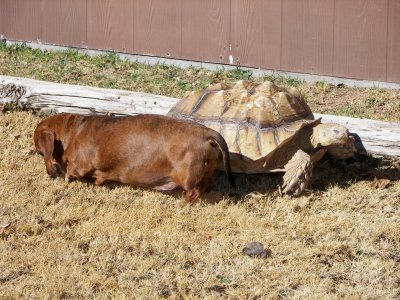Tortoises grow at a slow pace. They can take 10 to 20 years to reach full size.
Tortoises are fascinating creatures known for their longevity and slow growth. Different species of tortoises grow at varying rates, influenced by factors such as diet, habitat, and overall care. In captivity, proper nutrition and environment can help them grow steadily.
Wild tortoises, on the other hand, may experience slower growth due to natural challenges and food scarcity. Their shells, which are made of bony plates, harden and expand as they mature. Understanding the growth patterns of tortoises is essential for their care and conservation. Enthusiasts and pet owners should be patient and provide the best conditions to support their gradual development.

Credit: www.reddit.com
Tortoise Growth Stages
Tortoises are amazing creatures with unique growth patterns. Understanding their growth stages is important for proper care. Let’s explore the different phases of a tortoise’s growth.
Hatchling Phase
The hatchling phase starts right after a tortoise hatches from its egg. Hatchlings are very small and delicate. They usually measure between 1 to 2 inches in length. At this stage, they are highly vulnerable and need special care.
During the first few weeks, hatchlings grow rapidly. They require a diet rich in calcium and vitamins. Their shells are soft, and they need a warm environment to thrive. Proper hydration is also crucial at this stage.
Juvenile Phase
After the hatchling phase, tortoises enter the juvenile phase. This phase can last several years. Juvenile tortoises grow more slowly compared to hatchlings. They typically measure between 3 to 6 inches in length.
Juveniles become more independent. Their diet becomes more varied, including greens and vegetables. Their shells harden, providing better protection. They still need a warm and humid environment to grow well.
Factors Influencing Growth
Understanding how fast tortoises grow is essential for their care. Several factors influence a tortoise’s growth rate. These include diet, nutrition, and environmental conditions. Knowing these factors helps ensure your tortoise grows healthy and strong.
Diet And Nutrition
Diet plays a crucial role in a tortoise’s growth. A balanced diet is key for proper growth. Tortoises need a variety of foods to thrive.
- Leafy greens: Provide essential vitamins and minerals.
- Vegetables: Carrots and bell peppers add nutrients.
- Fruits: Should be given in moderation due to sugar content.
It’s important to avoid foods high in oxalates. These can hinder calcium absorption. Calcium is vital for shell and bone development. Ensure you provide a calcium supplement if needed.
Environmental Conditions
Environmental conditions significantly impact a tortoise’s growth. Proper lighting, temperature, and humidity are critical.
| Factor | Importance |
|---|---|
| Lighting | Essential for vitamin D3 synthesis and calcium absorption. |
| Temperature | Maintains metabolic rate and digestion. |
| Humidity | Prevents dehydration and promotes shell health. |
Ensure your tortoise has a UVB light source. This light mimics natural sunlight. It aids in vitamin D3 production. Keep the habitat at optimal temperatures. For most species, this ranges between 75°F and 85°F. Humidity levels should be adjusted based on species needs.
Proper care and attention to these factors ensure your tortoise grows at a healthy rate. Always monitor and adjust conditions as needed.
Different Species, Different Rates
Tortoises are fascinating creatures known for their slow and steady pace. Different species of tortoises grow at different rates. Understanding these growth rates is crucial for proper care and habitat planning.
Common Tortoise Species
Several tortoise species are popular among pet owners. Each has unique growth characteristics.
- Sulcata Tortoise
- Russian Tortoise
- Leopard Tortoise
- Greek Tortoise
Species-specific Growth Rates
The growth rate of a tortoise varies significantly by species. Knowing the average growth rates helps in monitoring their health and well-being.
| Species | Average Growth Rate |
|---|---|
| Sulcata Tortoise | 15-20 inches in 10 years |
| Russian Tortoise | 5-10 inches in 10 years |
| Leopard Tortoise | 10-18 inches in 10 years |
| Greek Tortoise | 5-8 inches in 10 years |
Each species has a unique growth pattern. Some grow fast, while others grow slowly.
- Sulcata Tortoise: One of the largest. They grow quickly in the first few years.
- Russian Tortoise: Smaller and slower-growing. They reach maturity at about 5-10 inches.
- Leopard Tortoise: Medium-sized. They grow steadily over the years.
- Greek Tortoise: Smaller. They grow slowly, reaching about 5-8 inches.
Proper diet and habitat play a crucial role in their growth. Ensure a balanced diet and spacious habitat.
Measuring Growth
Tortoises grow at different rates depending on their species and environment. Monitoring their growth is essential for their health. Growth can be tracked by measuring their shell and weight.
Shell Measurements
One way to measure growth is by checking the shell size. Use a ruler or caliper to measure the shell length. Measure from the front to the back of the shell. Record the length in a notebook for future reference.
Take measurements every month to track growth. Consistent measurements help you notice growth patterns. If the shell grows slowly, consult a vet.
Weight Tracking
Another method is tracking their weight. Use a digital scale for accuracy. Weigh the tortoise once a month. Record the weight in a logbook.
Comparing weight over time shows growth trends. A healthy tortoise gains weight steadily. Sudden weight loss may indicate health issues. Regular weight checks help maintain their well-being.
Healthy Growth Tips
Ensuring your tortoise grows healthily involves several key factors. These factors include diet and habitat. This section will provide tips for healthy growth.
Balanced Diet
A balanced diet is crucial for your tortoise’s growth. Tortoises need a diet rich in vitamins and minerals.
- Provide fresh vegetables like kale, collard greens, and dandelions.
- Include fruits such as strawberries and apples in moderation.
- Supplement their diet with calcium and vitamin D3.
Always avoid feeding them dog or cat food. These foods contain high protein levels harmful to tortoises.
Proper Habitat
The right habitat ensures your tortoise grows well. A proper habitat mimics their natural environment.
- Maintain a warm temperature between 75-85°F (24-29°C).
- Provide a basking spot with a temperature of 90-95°F (32-35°C).
- Ensure they have a UVB light source for 10-12 hours daily.
- Use a substrate like soil or coconut coir for burrowing.
A spacious enclosure allows your tortoise to move freely. This exercise is essential for their physical health.

Credit: www.anapsid.org

Credit: www.reddit.com
Frequently Asked Questions
How Fast Do Tortoises Grow Annually?
Tortoises grow slowly, averaging about 1-2 inches annually. Growth rates vary by species and environmental factors.
What Factors Affect Tortoise Growth Rates?
Tortoise growth rates depend on species, diet, environment, and overall health. Proper care ensures optimal growth.
When Do Tortoises Reach Full Size?
Tortoises generally reach full size between 10-20 years. This varies widely among species and individual conditions.
Do All Tortoises Grow At The Same Rate?
No, tortoise growth rates differ by species. Individual health and environmental factors also influence growth rates.
Conclusion
Understanding tortoise growth can help in providing the best care for these unique pets. Their growth rate depends on species, diet, and environment. Regular monitoring ensures they thrive in their habitat. With patience and proper care, you can enjoy watching your tortoise grow and lead a healthy life.

Rakib Sarwar is a seasoned professional blogger, writer, and digital marketer with over 12 years of experience in freelance writing and niche website development on Upwork. In addition to his expertise in content creation and online marketing, Rakib is a registered pharmacist. Currently, he works in the IT Division of Sonali Bank PLC, where he combines his diverse skill set to excel in his career.
